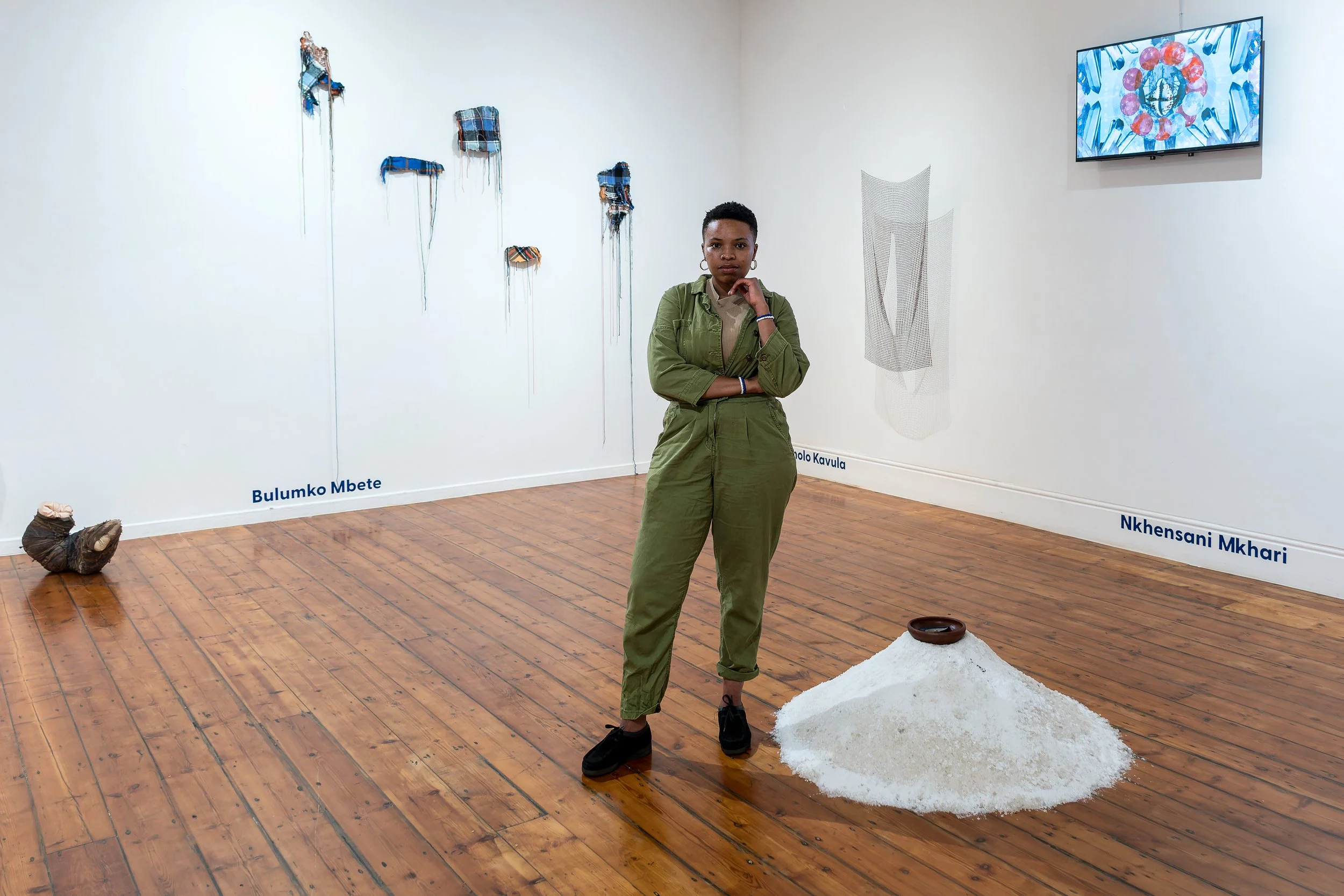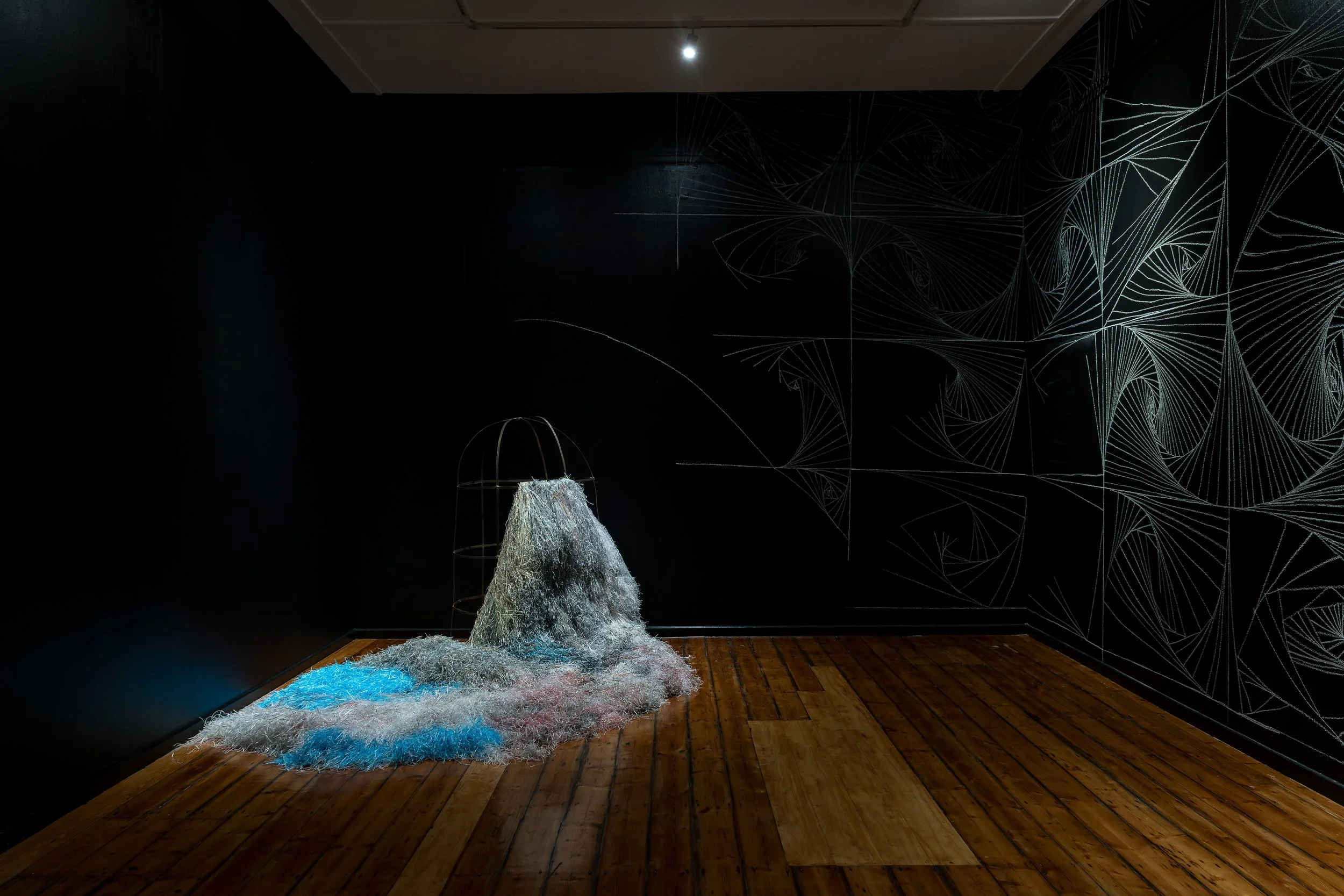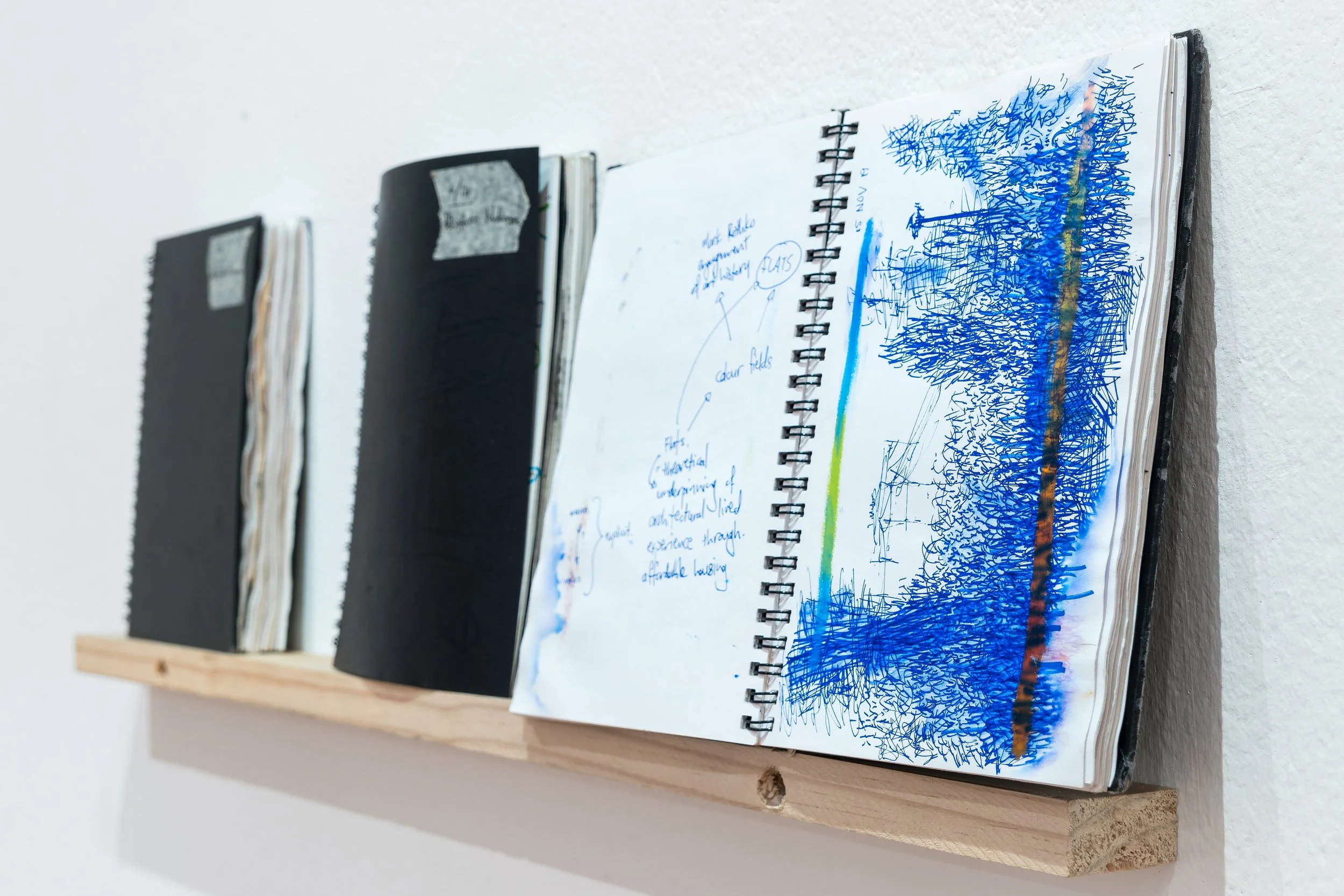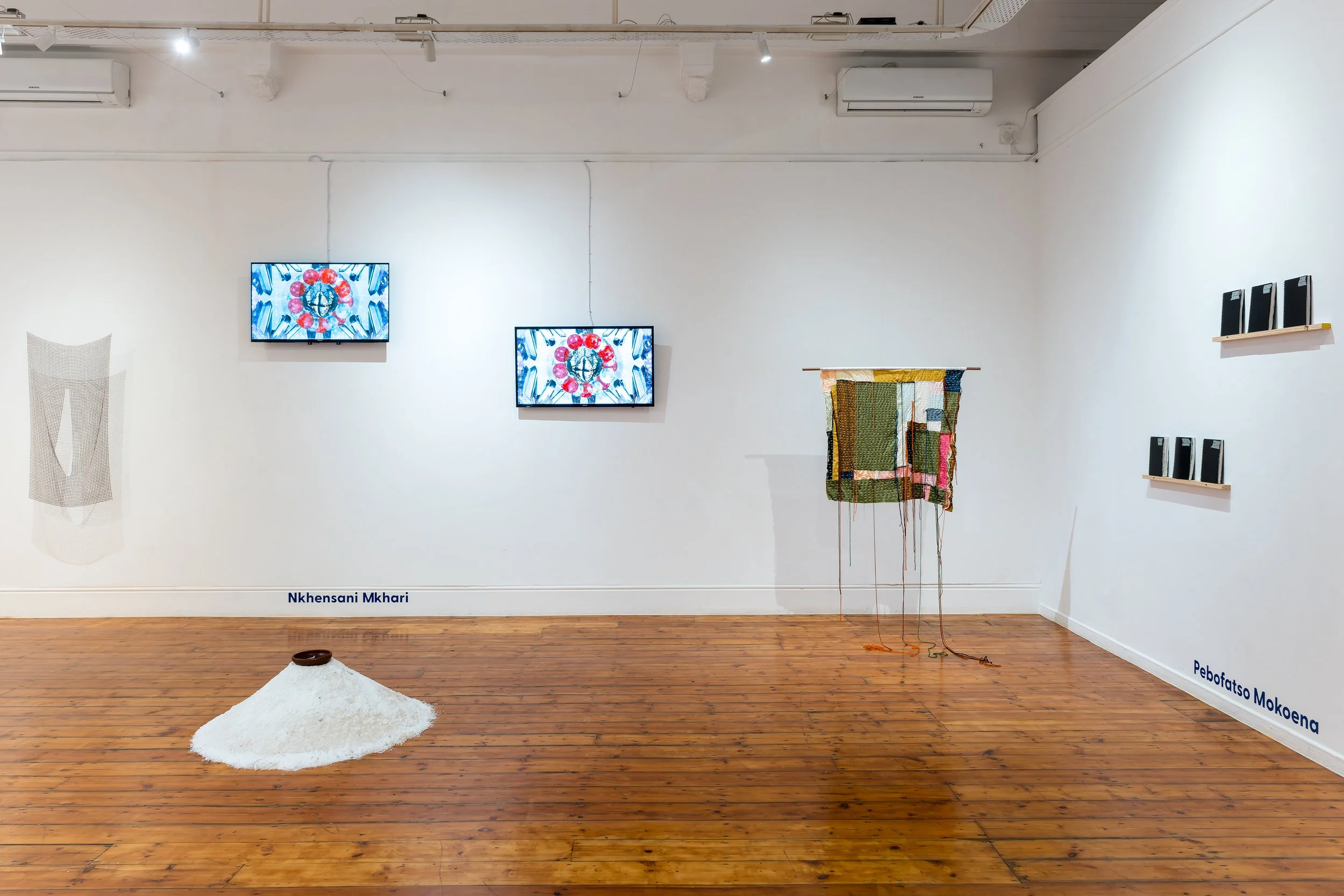SENSES OF TIME: A Play on Process in Two Acts
Interior. 11:20am, 2024.
A Virtual conversation between curator Kamogelo Walaza and writer Voni Baloyi. Both are seated on couches in their respective homes. (Kamogelo takes a brief pause and with a pensive expression concludes on an explanation of her curatorial practice.)
KAMOGELO
It’s also relying on your intuition, knowing that, okay, this person is the way that they think and
the way they do work.
KAMOGELO (CONT’D)
(Another pause.) So I feel like I don’t know man, like it’s a gift. Because creating is a gift.
VONI
(Voni begins to probe) A sense?
KAMOGELO
(Kamogelo’s shoulders relax as a smile crosses her face) Yes, a sense.
Figure 1: Image of curator of SENSES, Kamogelo Walaza. Courtesy of curator
Introduction
The second iteration of the successful group exhibition SENSES, which travelled from Johannesburg to find a temporary homing in the windy city of Cape Town, has been a feast of embodied engagement for the audience, delivering accurately on its namesake. Curated by Kamogelo Walaza under the mentorship of Nomusa Makhubu and funded by Creative Knowledge Resource, the exhibition exposes a history of collaboration at every point. With an expansive showcase of materiality and mediums from Bonolo Kavula’s notable pieces of punched out traditional material all held delicately with string, to Vusumzi Nkomo’s minimalist installation which makes you not only rethink a viewers connection or relation to the floor but also battling with the ontological terror Blackness has shown to be historically, there are many points of sensorial departure which are artfully held and connected in space through the thinking of curator Kamogelo Walaza.
The curatorial becomes a sense of its own. With this meditation in mind, I would like to reflect on Walaza’s improvisational curatorial practice with the help of disciplines that account for senses outside of just the visual, namely music and theatre. Understanding the temporality of a travelling exhibition, SENSES will be read in two acts whilst also leaning on theorization of the sonic that recovers the collaborative and improvisatory element to Walaza’s curatorial practice. So, in two acts I will be exploring the subversions Walaza offers to the art of exhibition-making. Namely, the sonic aspects to her curatorial practice highlighting elements of call-and-response between artist and curator, harmony through social practice and collaboration, and rhythm which is sounded between space and silence.
The First Act: Subversion
A Brief History on Exhibition-Making
In order to understand the subversive elements of Walaza’s curatorial approach in this exhibition, a brief history of exhibition-making as understood through Western thought on curatorial studies is in order. Art historian Tony Bennet speaks of the exhibitionary complex created by the gallery space and historically omniscient figure of the invisible curator where display of power became paramount - whether this be art that stood as an exemplar for nationhood, or the cabinet of curiosities excavated from violent colonial expeditions (Bennet, 1988) . This creates a complex which controls how people feel they should exist within a gallery space in order to attain the level of respectability of the objects which adorned the walls. A symptom of this then becomes what Dorothee Richter calls a cartesian perspective which delineates the distinctive realms between object and viewer which within the gallery space maintain a spatial distance of which produce a gaze based on the central perspective of the viewer (Richter, 2010: 3) . Moreover boundaries, composition and and the privileging of the absolute is read in the function of the frame, canvas, photograph or 2-D visual experience which confines within the frame what you ought to be paying attention to where Brian O’Doherty exposes that, “Eventually, editing, cropping - establishing limits - become major acts of composition” (O’Doherty, 1999 :19).
The Visible Curator
The act of defining limits becomes central to the curatorial practice historically as galleries, salons and museums are seen as sites to make meaning of objects, the curator servicing as a middle human between maker and viewer who disseminates said information. However, Walaza disrupts this nexus through her distinctive practice that questions the hierarchical nature of the exhibition and calls into question the invisibility of the omniscient curator. Walaza explains her curatorial practice succinctly, firstly bringing our attention to the social practice element to her approach. Like any relationship Walaza explains the importance of consistency in contact between artist and curator is important in building a foundation of trust. Unlike the excavative means shown in the history of exhibition-making, Walaza does this in order to cement her intentions of realising the artist’s autonomy in not just the artistic process, but the curatorial process too.
With social practice implemented, what follows next is what Walaza refers to as “process-led creative research.” This is foregrounded with an extensive knowledge of the artist’s wider practice and then further motivated by these points of contact between artist and curator being used as provocations and sites of questioning that then hopefully propel the artist into critically engaging with how feedback is worked back into the art. Walaza describes this process as incremental which I find significant as it is an indication of understanding what role time has not only in processes of making, but within the visual, sonic and physical arts in particular.
Sounding Harmony
The incrementality that Walaza points to within this process-led creative research actually brings sonic theorization right to the fore as the playing of notes within a harmonic tonic can be the clearest way to see how incremental change of one note can colour an overall tone in a completely different pitch.
The manner in which art has been mediated is embedded in the hierarchical manner in which information is controlled and disseminated. The curatorial process is not exempt from that hierarchy as curators select works whilst excluding others, and bring to our attention certain visual aspects whilst most times without the intention silencing other visual makers. The process removes the artists at the point of production being completed, however Walaza offers our second subversion in attempting to dismantle the scaffolding of this hierarchical positioning. The idea of harmony becomes a good analogy for what Walaza has created here. In order to sound harmony you must be able to acknowledge the unification of different melodies working together. Here, the melodies consist of artist, curator, and space - if one aspect changes the tone of the harmony changes colour. Movement and temporality becomes an aspect within the exhibition that aids a speculative and improvisational colouring that shifts and changes depending on space, and artist.
Figure 2: Installation image of Brian Montshiwa’s Ho kgaba ka masiba (2023). Courtesy of photographer.
Brian Montshiwa’s sculptural work accompanied with inscribed haptic drawings on the wall is an example of such harmonies that test our conception of temporality. Ho kgaba ka masiba (2023) which works as an ode to the Basotho material construction of a sounding skirt which traditionally is made from recycled materials, mostly plastic-based. The sculpture formed on arch-like scaffolding softly unfurls to expose the inner structure. It sits off-centre, closer to the corner, enclosed by the walls of the small black room, chalk creating hallucinatory lines that you follow from wall to wall until they disintegrate against the black abyss (if the abyss even has a colour). When previewing the exhibition I was shocked to see Brian in the space, diligently marking the walls, as it became clear how committed Walaza was to her vision. In order to sustain harmony the process, although the space changed, continued within the context of Cape Town. What is clear is the haptic drawings read much looser than those that were exhibited in the Goethe space. When reflecting on this collaboration between Montshiwa and herself she remarks that during installation she would continuously walk into the room and through conversation and passive prompting leave Montshiwa only to come back to see how the advice is worked into the piece - live. In real-time. On location. With the constant being the foundation of the social practice, it invites viewers who engage with the work to welcome it as a site of ever-changing form, ideas, and potentials. In essence our harmony finds a different colour in this second iteration, although the intent remains steadfast. Simultaneously, Walaza subverts any hierarchical notion that that artist must exist within their silo of isolated production, rather calling into question when does production end and exhibition-making begin?
The Second Act: Call-and-response and Improvisation
The second installation work which truly encompasses the sonic elements of improvisation and call-and-response is Zenaeca Singh’s land of brick and desolation entitled As a family II (2024). The weight of the cement blocks against the fragility of negative space caused by the sugar reflects on Singh’s own embodied re-tracing of communal and familial trauma in the form of Indian indentured labour and the remnants of apartheid as she traverses the construction of her own Indian identity within this contemporary context. I use the word embodied here intentionally as Singh tells me the inspiration for the piece, sharing that her grandfather’s career as a teacher was abruptly thwarted by the State due to his anti-apartheid activism. This forced him to find work as brickmaking as a means to provide for his family - a vocation which remained in and sustained the family. With this in mind Singh takes on this embodied memory of labour in recreating this installation of brick and sugar, the latter acting as a signifier of the sugar cane farming of KwaZulu Natal, synonymous with the indentured labour of Indian South Africans.
Figure 3: Installation image of Zenaéca Singh’s As A Family II (2024). Courtesy of photographer.
The embodiment does not end there as this piece which is an iteration of an initial work created by Singh in 2022, we as an audience are also witnessing an improvisatory revisiting of a once crystalized artwork. Improvisation, an appealing element to Jazz which answers for what types of knowledge production come to the surface when we begin to approach production with elements of play and speculation, is aptly translated to this moment of contact between Singh and the larger exhibition. On an improvisatory whim to fill the larger space that is Michaelis Galleries, Zenaeca Singh, along with Cazlynne Peffer, Ntsako Nkuna and Vusumzi Nkomo, joined the list of artists for SENSES Cape Town edition. Through call-and-response within the exhibition space underpinned by the social practice framework, Walaza engaged with Singh on this embodied revisiting and slowly a rectangular shape 2022 work slowly morphed into a circular land of brick and sugar on the Michalis gallery floor over the span of 48 hours. Similar to Montshiwa’s haptic world-building, the exhibition again questions not only the positioning of the artist within the exhibition space, but the temporal configurations of an artwork. What does it mean to revisit the already determined? What does it mean to question the laws of composition? In essence, not only space, but time itself can colour a work in a completely different tonal air, a subversive air which tests how good your senses really are when elements are changing over time.
Sounding Rhythms: A Question of Time
Pebofatso Mokoena’s Sketchbook Installation becomes a microcosm for the effects of time as he exhibits personal notebooks which chronicle thirteen years of his life. Apart from the physical sense of being able to touch and interact with the textbooks in the space, as you page through the notebooks, what the artist inadvertently asks of you is to tap into a temporal sense which is sensitive to changes in time. As we view the notebooks, the cluttered aspects of some, to more mathematical doodlings of others gives an indication of a changing and evolving mind, even if the content is illegible in the traditional sense of the word.
Figure 4: Detail image of Pebofatso Mokoena’s Notebook Installation (2023). Courtesy of photographer.
The display of the notebooks follow a rhythm of their own indicative to the rhythms created through space, occupation, and silence. When entering the second space of the gallery the blocking of the exhibition also dictates your sense of movement as you are met by multiple sculptures grounded by their direct contact with the floor. Both ascending and descending scales surface through the rhythm in movement from Kavula’s delicate piece which is suspended slightly distances from the wall creating excellent shadow play, to Bulumko Mbete’s pieces that work like visual ladders which lead you to the crescendo point that is Nkensani Mkari’s video and sounds installation in the centre. This then descends into Mokoena’s notebooks. When I ask Walaza about the choices in blocking, she signals to the concept of rhythm, highlighting how she uses the space between works as those beats of silence. Without them, we cannot make sense of the beat, the beat in this case being the moment we engage with the work.
Where rhythm can denote movement, the element of rhythm in this exhibition speaks to this overarching reality of what a travelling exhibition affords us as viewers. Time is consistently at play where we get to examine its impact on temporal planes that leaves its own rhythm in the cultural landscape of South African visual cultures. Speaking on how we read this exhibition against a larger culture of exhibition-making, Walaza shared her own concern with the ephemerality of exhibitions and why travelling was an important aspect to her, admitting that having the opportunity to travel with SENSES gave her the opportunity to ask what this exhibition could look like if expanded or dislocated from its original locale. She adds that the fleeting nature of exhibitions as it pertains to existing in a particular space at a particular moment does not account for the archival discrepancies we might face at a later stage, especially as an independent curator. The element of movement here calls us to question what constitutes the limits of time ascribed to the exhibition? What happens not only to the exhibition, but the works themselves when we play with the element of time tethered to the foundation of speculative and improvisatory play and process?
Figure 5: Installation image of SENSES exhibition. Courtesy of photographer.
If we turn to SENSES, multiple answers may come to the surface, however for myself, to have the ability to revisit something knowing it will never be the same in this modernist white cube world that privileges framing, compartmentalising, and contextualising in order to arrive to absolute truths is daunting, yet necessary. I use the word necessary here because you soon come to find that the only thing a sense of time can truly guarantee is change, instantaneously subverting any presumptions that the curatorial is an exercise in crystallisation. Rather the curatorial becomes an exercise of moving between crystallisation and the melting down of matter in order to make out all these connected elements in a form, location, or time removed from what it was originally connected to.
Notes
Bennett, T. 1988. The Exhibitionary Complex. New Formations. (4): 73-102.
O’Doherty, Brian. 1976. Inside the White Cube: The Ideology of Gallery Space. San Francisco:
The Lapis Press. “Notes on the Gallery Space”, pp. 13 – 34.
Richter, D. 2010. “A Brief Outline of the History of Exhibition Making”, in “1,2,3, - - - Thinking
About Exhibitions”, on-curating, (6): pp. 28 — 37.





